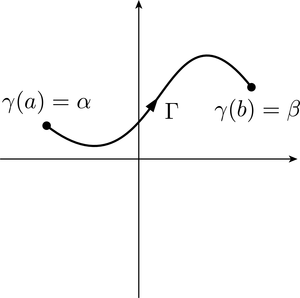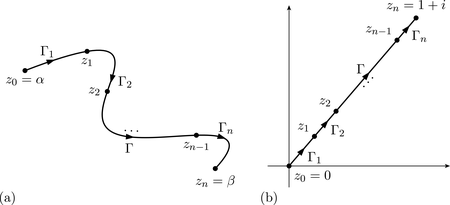1.4 Introducing complex integration
We come now to the central theme of this course – integrating complex functions. Informed by the discussion in the introduction, we should expect that the integral of a continuous complex function from one point to another point in the complex plane may depend on the path that we choose to take from to . So it is necessary to first choose a smooth path such that and (see Figure 14), and then we will define the integral of along this smooth path, denoting the resulting quantity by
There are two ways to achieve this goal.
One method is to imitate the approach of Section 1.2, as follows.
Choose a partition of the path into subpaths
determined by points , , …, , such as those illustrated in Figure 15.
Define a complex Riemann sum
where , for , and define
Define the complex integral to be
where is any sequence of partitions of for which as .
It can be shown (although it is quite hard to do so) that this limit exists when is continuous, and that it is independent of the choice of partitions of . Thus we have defined the integral of a continuous complex function. We can then develop the standard properties of integrals, such as the Additivity Rule and the Combination Rules, by imitating the discussion of the real Riemann integral.
The second, quicker method is to define a complex integral in terms of two real integrals. To do this, we use a parametrisation of the smooth path , where and . Any set of parameter values
yields a partition
of , where is the subpath of that joins to , for . We can then define the complex Riemann sum
where , for ; see Figure 16.
Notice that
Hence, if is close to , then, to a good approximation,
where , so
Thus if is small, then, to a good approximation,
The expression on the right has the form of a Riemann sum for the integral
Here the integrand
is a complex-valued function of a real variable. We have defined integrals of only real functions so far, but if we split into its real and imaginary parts , then the integral (1) above can be written as
which is a combination of two real integrals. We then define the integral of along by the formula
It can be shown that both of these methods for defining the integral of a continuous complex function along a smooth path give the same value for
In the next section we will develop properties of complex integrals, and there we will use the formula (2) above for the definition of the integral of a complex function along a path .
History of complex integration
The first significant steps in the development of real integration came in the seventeenth century with the work of a number of European mathematicians. Notable among this group was the French lawyer and mathematician Pierre de Fermat (1601–1665), who found areas under curves of the form , for an integer (possibly negative), using partitions and arguments involving infinitesimals.
A major breakthrough was the discovery of calculus made independently by the English mathematician and scientist Isaac Newton (1642–1727) and the German philosopher and mathematician Gottfried Wilhelm Leibniz (1646–1716). They observed that differentiation and integration are inverse processes, a fact encapsulated in the Fundamental Theorem of Calculus.
Towards the end of the eighteenth century, mathematicians began to consider integrating complex functions.
Two pioneers in this endeavour were Leonhard Euler and Pierre-Simon Laplace. They were mainly concerned with manipulating complex integrals in order to evaluate difficult real integrals such as
However, it was through the work of Augustin-Louis Cauchy that complex integration began to assume the form that is now used in complex analysis. Cauchy’s first paper on complex integrals in 1814 treated complex integrals as purely algebraic objects; it was only much later that he came to properly appreciate their geometric significance.
By the mid to late nineteenth century, mathematicians began to consider how to expand the theory of integration to deal with functions that are not continuous. The first rigorous theory of integration to do this was put forward by Riemann in 1854. The Riemann integral was followed by a number of other formal definitions of integration, some equivalent to Riemann’s, and some more general, such as Lebesgue integration, named after the French mathematician Henri Lebesgue (1875–1941).



